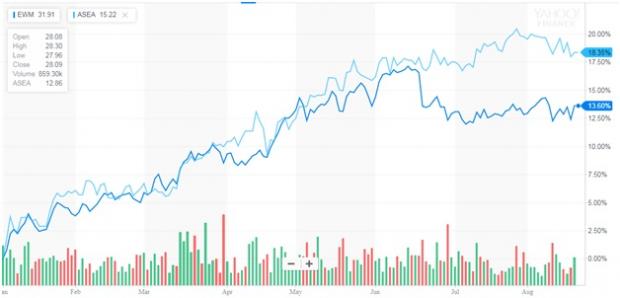Malaysia’s central bank has said that its GDP grew 5.8% year over year in the second quarter of 2017 compared with 5.6% in the first quarter. It surpassed a Reuters forecast of 5.4%.
This is the highest rate of growth in two years and Bank Negara Malaysia attributed it to higher domestic demand and better exports, owing to the global trade recovery. The stronger-than-expected results might act as a catalyst for prime minster Najib Razak to call for early elections.
Moreover, the central bank updated its full-year 2017 growth forecasts to more than 4.8%, owing to stronger-than-expected data. Its previous forecast in March for GDP growth was between 4.3-4.8%.
Consumer prices in Malaysia increased 3.6% year over year in June 2017 compared with a 3.9% in May. Moreover, Bank Negara Malaysia’s governor expects it to be in the range of 3-4% for the rest of the year.
Also, the central bank left its Overnight Policy Rate (OPR) unchanged last month amid reduced economic growth worries and easing inflation woes. Bank Negara Malaysia left its benchmark interest rate unchanged at 3.00%.
Consumer spending surged 7.1% in the second quarter of 2017 from the year-ago period. Investments expanded 7.4% from the year-ago period but decreased against a 12.9% expansion in the first quarter of 2017.
While the economy’s biggest sector, services, grew 6.3% in the quarter from the year-ago period, manufacturing expanded 6%. Moreover, exports climbed 9.6% while imports increased 10.7%. The current account surplus increased to 9.6 billion ringgit from 5.3 billion ringgit in the first quarter.
Let us now discuss the ETF providing exposure to Malaysian equities (see all the Asia Pacific ETFs here).
iShares MSCI Malaysia ETF EWM
This fund is a pure play on Malaysia and is appropriate for those looking to gain exposure to this emerging market nation.
EWM has AUM of $435.60 million and charges a fee of 48 basis points a year. From a sector look, Financials, Industrials and Utilities are the top three allocations of the fund, with 31.24%, 14.86%, and 14.47% exposure, respectively (as of August 17, 2017). From an individual holdings perspective, Public Bank, Tenaga Nasional Bhd, and Malayan Banking are the top three holdings of the fund, with 12.34%, 9.94%, and 7.13% allocation, respectively (as of August 17, 2017). The fund has returned 13.60% year to date but has lost 4.58% in the last one year (as of August 18, 2017). EWM currently has a Zacks Rank #3 (Hold) with a Medium risk outlook.
We will now compare the performance of EWM with a broad-based South East Asian ETF, ASEA.
Global X Southeast Asia ETF ASEA
This fund provides broad exposure to the five members of the Association of Southeast Asian Nations, Singapore, Indonesia, Malaysia, Thailand, and the Philippines. It is appropriate for investors looking for a diversified exposure to South East Asia (read: Singapore GDP Growth Surpasses Estimates: ETFs in Focus).
ASEA is less popular with AUM of $13.74 million and charges a fee of 65 basis points a year. From a geographical perspective, the fund has 30.45% exposure to Singapore, 22.29% to Malaysia, 21.15% to Thailand, 19.67% to Indonesia and 6.44% to Philippines (as of June 30, 2017). Financials, Telecommunication Services and Industrials are the top three sectors of the fund, with 45.92%, 14.94% and 8.12% allocation, respectively (as of June 30, 2017). DBS Group Holdings Ltd, Oversea-Chinese Banking Ltd and United Overseas Bank Ltd are the top three holdings of the fund, with 7.22%, 7.08% and 5.83% allocation, respectively (as of August 18, 2017). The fund has returned 7.49% in the last one year and 18.35% year to date (as of August 16, 2017). ASEA currently has a Zacks Rank #3 with a Medium risk outlook.
Below is a chart comparing the year-to-date performance of the two funds.

Source: Yahoo (NASDAQ:AABA) Finance
Want key ETF info delivered straight to your inbox?
Zacks’ free Fund Newsletter will brief you on top news and analysis, as well as top-performing ETFs, each week. Get it free >>
ISHARS-MALAYSIA (EWM): ETF Research Reports
GLBL-X SE ASIA (ASEA): ETF Research Reports
Original post
Zacks Investment Research
